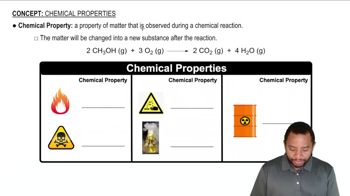From the following list of elements—Mg, Li, Tl, Pb, Se, Cl, Xe, Si, C—pick the one that best fits each description. Use each element only once: (a) an alkali metal, (b) an alkaline earth metal, (c) a noble gas, (d) a halogen, (e) a metalloidin group 14, (f) a nonmetal listed in group 14, (g) a metal that forms a 3+ ion, (h) a nonmetal that forms a 2- ion, (i) an element that is used as radiation shielding.
Ch.2 - Atoms, Molecules, and Ions
Chapter 2, Problem 102
The explosion of an atomic bomb releases many radioactive isotopes, including strontium-90. Considering the location of strontium in the periodic table, suggest a reason why this isotope is particularly dangerous for human health.
 Verified step by step guidance
Verified step by step guidance1
Step 1: Identify the position of strontium in the periodic table. Strontium (Sr) is located in Group 2, which is the alkaline earth metals group.
Step 2: Understand the chemical properties of strontium. As an alkaline earth metal, strontium behaves similarly to calcium, which is also in Group 2.
Step 3: Consider the biological role of calcium. Calcium is essential for human health, particularly in the formation and maintenance of bones and teeth.
Step 4: Analyze the potential for strontium to mimic calcium. Due to its chemical similarity, strontium can replace calcium in biological systems, particularly in bones.
Step 5: Discuss the implications of radioactive strontium-90. When strontium-90 replaces calcium in bones, its radioactivity can cause damage to bone marrow and increase the risk of cancer, making it particularly dangerous for human health.
Key Concepts
Here are the essential concepts you must grasp in order to answer the question correctly.
Radioactive Isotopes
Radioactive isotopes are variants of chemical elements that have unstable nuclei and emit radiation as they decay. This process can lead to the release of harmful radiation, which can damage living tissues and DNA. Strontium-90, a byproduct of nuclear fission, is particularly concerning due to its beta radiation and long half-life, making it a persistent environmental hazard.
Recommended video:
Guided course

Isotopes
Chemical Properties of Strontium
Strontium is located in Group 2 of the periodic table, which means it is an alkaline earth metal. These metals are known for their reactivity and ability to form compounds with biological significance. Strontium-90 can mimic calcium in biological systems, leading to its accumulation in bones and teeth, which poses serious health risks, including cancer.
Recommended video:
Guided course

Chemical Properties
Health Effects of Radiation
Exposure to radiation can lead to various health issues, including acute radiation sickness and long-term effects such as cancer. The ionizing radiation emitted by radioactive isotopes like strontium-90 can cause cellular damage and mutations. The risk is heightened when such isotopes are ingested or inhaled, as they can directly affect internal organs and tissues.
Recommended video:
Guided course

Photoelectric Effect
Related Practice
Textbook Question
1
views
Textbook Question
The first atoms of seaborgium (Sg) were identified in 1974. The longest-lived isotope of Sg has a mass number of 266. (a) How many protons, electrons, and neutrons are in an 266Sg atom?
3
views
Textbook Question
The first atoms of seaborgium (Sg) were identified in 1974. The longest-lived isotope of Sg has a mass number of 266. (b) Atoms of Sg are very unstable, and it is therefore difficult to study this element's properties. Based on the position of Sg in the periodic table, what element should it most closely resemble in its chemical properties?
1
views
Textbook Question
From the molecular structures shown here, identify the one that corresponds to each of the following species: (a) chlorine gas; (b) propane; (c) nitrate ion; (d) sulfur trioxide; (e) methyl chloride, CH3Cl.
